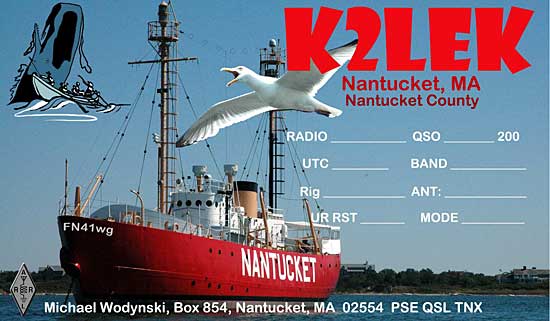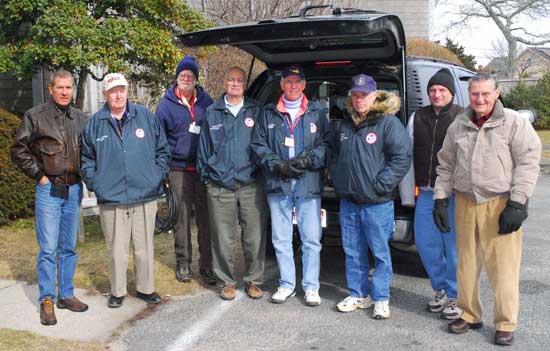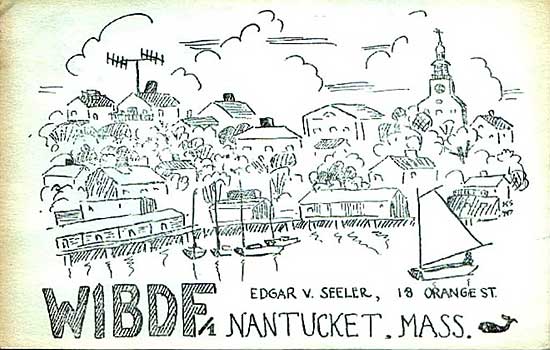Creatures of the Sun -
Ham Radio Operators & Nantucket
by Kenneth Turner Blackshaw
Okay, I’ll tell the truth. I am a “Ham.” That is, I am an amateur radio operator. I have been licensed by the FCC since 1956 and other hams know me by my call sign – W1NQT. That second figure is a one – not an “L.”
Most folks think ham radio is an anachronism, and indeed you are on the right track. Although there are more than 20 licensed hams on Nantucket, I can only think of one that is younger than 40 years old. Most of us are 60 plus.
Ham radio operators are creatures of the sun. Most of us don’t have tans, but we live by something called the Solar Cycle. Our sun goes through a cycle every 11 years where sunspots come and go. You are probably only vaguely aware of sunspots but their presence or absence can have quite an affect on our planet.

If there are a lot of sunspots, the upper levels of our atmosphere get quite excited, and so do radio operators. Hams around the world (almost 3 million have licenses) are anticipating sunspot cycle 24. My ham radio history started with Solar Cycle 18.
That was back in the early 1950s when Nantucket was a very different place. Almost no one had a TV set. I remember going to a friend’s home to see a Red Sox game – shadowy figures on the screen and we could never actually see the ball. Radios were the little boxes we clustered around to keep in touch with America and the world.
We lived on Chestnut Street. My family owned the Inquirer and Mirror newspaper. My grandmother, Grace Turner, would come down the hallway every morning to wake up my uncle Gordon. Gordon was a ham radio operator, W1QWI. “Nana Grace” would turn on Gordon’s radio and then continue on down the back stairs to start things going in the kitchen. Soon I would hear strange accented voices calling “CQ,” as well as smell good aromas of breakfast. These same stimulants would reach Gordon’s sleepy head and he would rouse and move over to his operating position in his radio “shack” and start answering those voices from around the world. Although we lived on an island, miles from anywhere it seemed, this little side-room off his bedroom became like a nerve center connected to everywhere.
In the morning, it was Europe coming in. Later in the day it was Africa. I learned about Mozambique and South Africa before I learned about New Jersey. Around dinnertime we would hear Argentina and then into the dusk the skip would work westward and the charming accents of New Zealand and Australia were there with us.

After Gordon made a contact, he would write out a special card called a QSL card that he would send through the mail to confirm he had talked to that other person. In return, postcards came to Nantucket from exotic places and would get taped up like wallpaper on the walls of the radio shack around the special map that we would use to aim our antenna across the great circle path to anywhere on the planet.
I learned that radio was more than turning dials and talking into microphones. No, it also involved getting up on our roof and assembling great metal structures called beams with electric rotors attached. As I walked up Chestnut Street I’d look to the roof and know whether Gordon had been talking to Europe or Texas by the way the beam was pointed.
I also learned inadvertently about the dangers of electricity one day when a piece of gear Gordon was working on set the carpet on fire in his bedroom. I ran down the stairs screaming, “The house is on fire!” thoroughly alarming Nana Grace and upsetting Gordon, who had quickly smothered the little flames with a blanket and was dismayed I’d gotten everyone excited.
In 1956, at age 15, I got my own ham license. I haven’t been continuously active on the ham bands but have kept renewing my “ticket” over the years, so I’ve kept my original call sign – W1NQT.
Hams use phonetics to get these call signs across, helping to distinguish ‘n’s from ‘m’s, ‘t’s from ‘d’s, for instance. Officially I would be “whiskey one November, Quebec, tango.” In reality hams like to have fun with these spelling aids. NQT proved a challenge for me. For 30 years I was stuck with “New Quarts of Tomatoes” – kind of nerdy. But in the mid-80s I ran into W8NQT in Ohio, and he rattled off “W 8 Never Quits Talking,” and I’ve been “W 1 Never Quits Talking” ever since. Some will tell you it’s quite appropriate.
So why do we care if the upper layers of earth’s atmosphere are excited or not? It’s the difference between radio waves skipping back to reach a spot on the other side of the earth, or having them just vanish out into space. It means that ham frequencies that are silent right now will become crowded with signals, voices from far away places.

When cycle 24 hits, hams with low powered radios and simple wire antennas will have the world, literally, at their fingertips. This is the way it was for me as a teenager in 1958. As a high school student I had received QSL cars from almost 100 different countries. I had them from all continents, including Antarctica. There were still some states that were eluding me. I was almost convinced that the states Utah and Montana had no one living in them. But ironically, Hawaii and Alaska were easy (although still not states themselves).
Here in the early 21st Century, hams still find ways to be radio pioneers. Fifty years ago it was Morse Code or AM radio. Now we have many more ways of communicating. Some hams transmit television pictures. Others are into digital modes. If you listen it sounds like the old “psssst” we used to do to attract someone’s attention, but with a computer connection, text prints out. We relay signals with passing ham satellites and even talk to other hams living on the International Space Station.
On Nantucket, local hams talk to each other using a repeater station that rebroadcasts our signals from a high spot, extending our line of sight to the whole island and the Cape. Hams developed repeater technology in the late 60s and it is the basis that everyone’s cell phones use today.
These days it’s not so tough to get your own license and callsign. You know longer have to learn to send and receive Morse Code, just some basic electronic theory and the FCC rules governing how you must operate. But with your license you will acquire a huge group of international friends, all waiting to talk to you.
If you like to fish, think of casting your line out into Nantucket’s waters. Some days you catch nothing, but you keep on casting. When you get a bite, you don’t know what’s on the end of your line until it reaches the beach.
If you love this, broadcasting your “CQ” into the ether from your radio provides the same thrill and mystery. You are casting your signal out, but how far? Who is out there waiting to hear your voice? Hearing a voice from afar repeating your callsign and then giving his (or hers) provides an unimaginable thrill. Your circle of friends will be almost infinite.
As I type these words into my computer, two ham radio transceivers glow beside me, one with at least three Morse Code signals from hams chatting with each other, their pitch separating one from the other. The other radio monitors the Nantucket Repeater to see if any local hams are out and about. Clicking onto the “DX Cluster” on the web, I can get a quick snapshot of what’s happening across the bands. I can see the top frequencies being used are in the 21 Megahertz range so I know Solar Cycle 24 is still in the future. I can also see that today is the day for the Bulgarian Radio contest. The bands are busy with hams from eastern Europe competing to see who can make the most contacts. By the time you read this you will have missed the contest. But – perhaps next year?